

ARCTIC SUMMER CLOUD-OCEAN STUDY (ASCOS)
The Arctic climate is changing fast. The rate of near-surface warming, averaged over an area north of 60°N, is about twice the global average. Perennial Arctic sea-ice cover is reduced at an alarming rate (2007 saw a record minimum in ice cover), glaciers in the north (including on Greenland) are retreating and permafrost (constantly frozen soil) areas are becoming smaller. This impacts the special ecology of the Arctic and local societies, and has potential knock-on consequences for global climate. Our primary tools for accessing climate change – global coupled climate models – do a poor job of representing arctic climate; climate-change projections from different models differ more for the Arctic than for any other region on Earth. This results, in large part, from the fact that the parameterizations of physical processes within the models are derived from measurements in mid-latitudes or the tropics, and are not necessarily appropriate for the unique Arctic environment. This in turn results from the scarcity of detailed measurements in the central Arctic.
 The
ASCOS programme is an international, multi- and interdisciplinary project aimed
at understanding the processes that control low-level arctic clouds and their
interaction with the sea ice and bio-chemical processes in the ocean. During
summer 2008 a team of scientists from 10 different countries undertook a 7-week
long cruise on the Swedish icebreaker Oden to make one of the most
extenisve sets of measurements ever made in the central arctic ocean. ASCOS
is an official International Polar Year (IPY)
project (under the umbrella of AICI-IPY),
and an international SOLAS project.
More information on ASCOS can be found on the main project web site at www.ascos.se
The
ASCOS programme is an international, multi- and interdisciplinary project aimed
at understanding the processes that control low-level arctic clouds and their
interaction with the sea ice and bio-chemical processes in the ocean. During
summer 2008 a team of scientists from 10 different countries undertook a 7-week
long cruise on the Swedish icebreaker Oden to make one of the most
extenisve sets of measurements ever made in the central arctic ocean. ASCOS
is an official International Polar Year (IPY)
project (under the umbrella of AICI-IPY),
and an international SOLAS project.
More information on ASCOS can be found on the main project web site at www.ascos.se
The Leeds group have a NERC funded project - Turbulent Exchange in the Arctic Boundary Layer - which forms the core of the ASCOS boundary layer measurement programme in collaboration with colleagues at the University of Stockholm, and a follow-on grant for analysis of the ASCOS data set.
The Arctic Climate Impacts Assessment (ACIA) report tells more about Arctic climate change: how it already impacts the animals, plants and people who live in the Arctic, and what the future might bring.
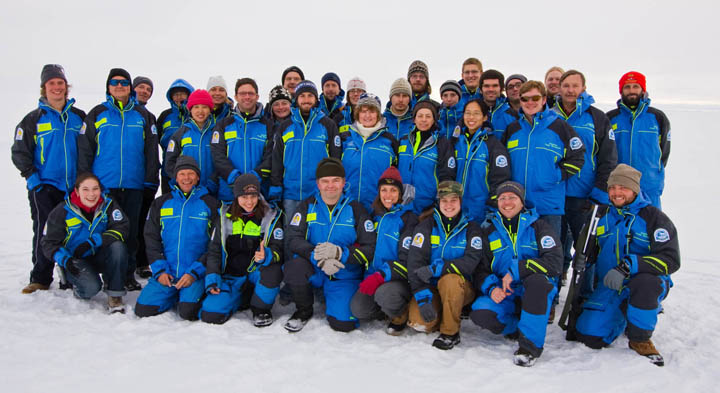
The Oden science team (photo by Thorsten Mauritsen)
 |
 |
|
| Sea ice during the transit north | Cathryn (right) and Thorsten sorting out cabling to instruments on the 15m micrometeorology mast. |
The surface meteorology team consisted of Ian Brooks & Cathryn Birch (Leeds), and Thorsten Mauritsen & Joe Sedlar (Stockholm). Between us we ran a 15m mast (5 levels of turbulent flux measurements, mean temperature, and humidity); a 30m mast (turbulent fluxes at the top); up- and down-welling solar and infrared radiative fluxes; a sodar (wind profiles and boundary layer structure); and a tethered balloon system (temperature, humidity, wind and turbulence). The balloon was run round the clock for about 3 weeks, with everyone working shifts to keep it going.

The tethersonde being recovered at the end of a flight by Ian & Cathryn (right), and just after launch (above). This balloon-borne system allowed us to extend high-resolution profile and turbulence measurements above the near-surface layer accessible from masts throughout the full depth of the boundary layer (usually less than 200m or so in the arctic) and into cloud, and sometimes through cloud top. The maximum altitude is limited by the increasing weight of tether that must be lifted. We got up to around 700 m during ASCOS. |
 |
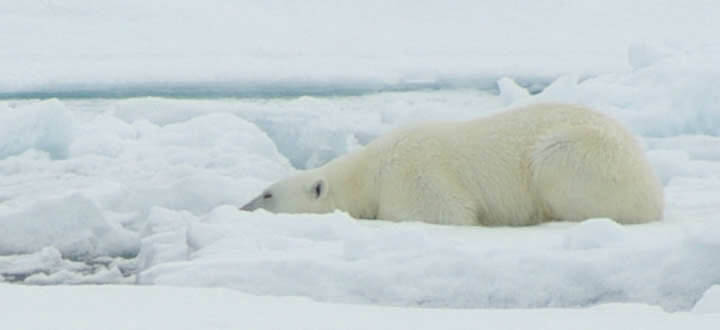
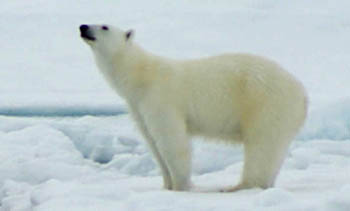 |
Polar bears can pose a significant threat so great care is taken to avoid close encounters. This bear wandered into the ice camp during the early hours of the morning - walking directly under the meteorology masts, and then moving off behind the ship where it settled down to wait for breakfast. Eventually it was chased off with flares and the helicopter so that we could get back out on the ice and resume work for the day. |
| Leeds also contributed to a related project - AMISA (Arctic Mechanisms of Interaction between the Surface and Atmosphere). Barbara Brooks flew the Leeds VACC aerosol instrument on the NASA DC8 research aircraft during a series of flights coordinated with the icebreaker. The DC8 flew above, within, and below cloud (as low as 100m over the ice), passing directly over the Oden (seen below approaching the sodar, and left a few seconds later). Other measurements on the aircraft include cloud microphysics, extensive radiation measurements, aerosol, and mean meteorology. Barbara is leading the analysis of all the aircraft aerosol and cloud microphysics measurements. |  |
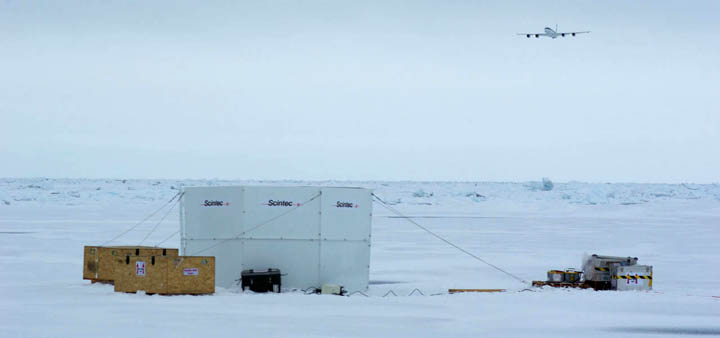
Barbara also contributed instrumentation to the aerosol lab on the Oden, looked after by Sarah Norris (moonlighting from the SEASAW project). The aerosol lab was packed with huge array of instruments (below), although at times the air was so clean there was nothing at all for them to measure - see this video made by Zoran Ristovski to see what happens when there are no aerosol particles to act as condensation nucleii for cloud/fog droplets.
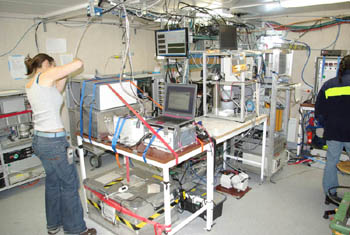 |
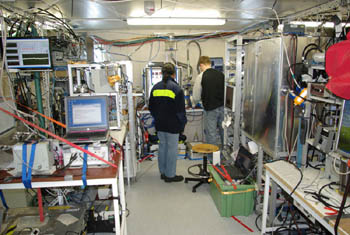 |
|
| The aerosol lab - (above left) Sarah adjusts the Leeds SMPS volatility system; (above right) Petri Vaattovaara (Univ. of Eastern Finland) setting up his kit watched by Rachel Chang (Univ. of Toronto); and (right) Olaf Stetzer (ETH, Zurich) setting up his system. | 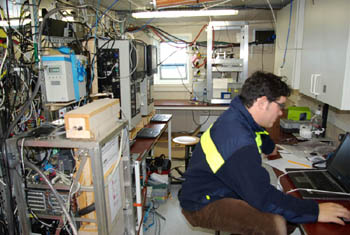 |
In addition to NERC funding the Leeds group received generous support from the Knut and Alice Wallenberg Foundation (Sweden) and DAMOCLES (EU 6th Framework Program) via the ASCOS coordinators Michael Tjernstrom and Caroline Leck at Stockholm University.